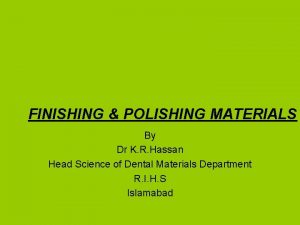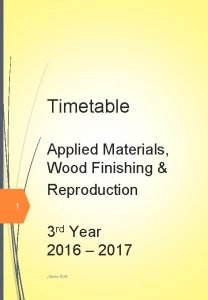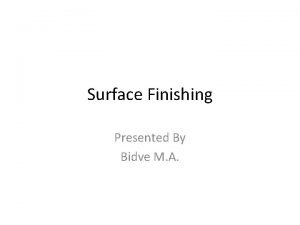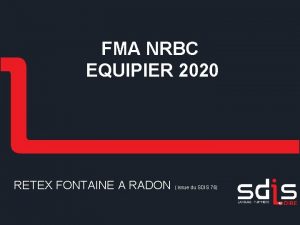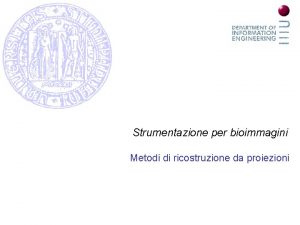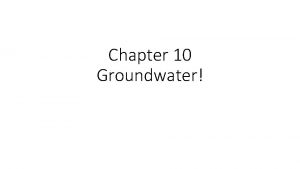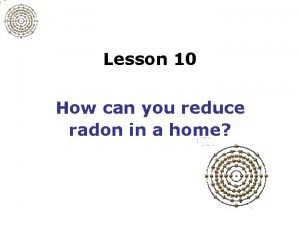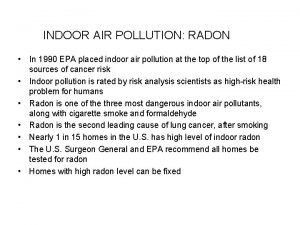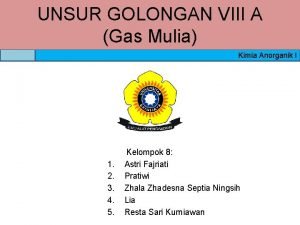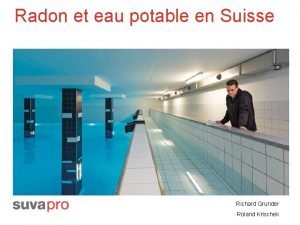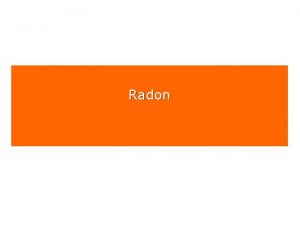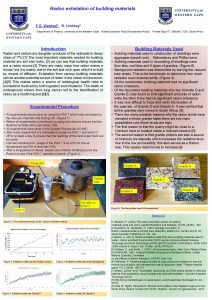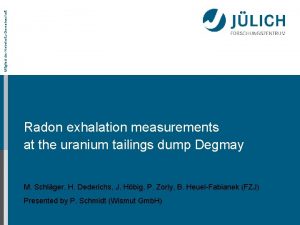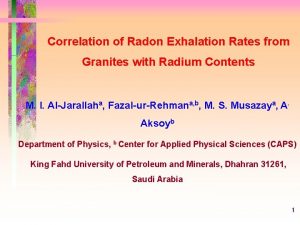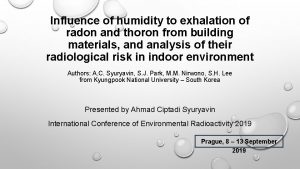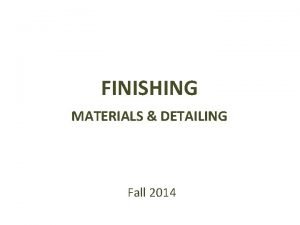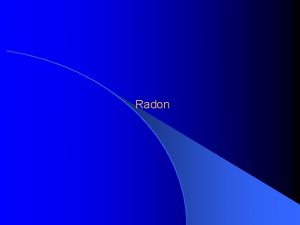Radon Exhalation from some Finishing Materials frequently used


















- Slides: 18

Radon Exhalation from some Finishing Materials frequently used in Syria R. Shweikani and G. Raja Atomic Energy commission of Syria (AECS), Damascus, P. O. Box 6091, Syria Corresponding author: rshweikani@aec. org. sy

The Objectives �This work describes the measurements performed to determine radon exhalation and natural radioactivity content (K 40, Ra 226 and Th 232) in different samples of ceramic and marble collected from the local markets. �In addition, the annual radiation doses to the occupant due to radon exhalation from using such finishing material in houses were also discussed and calculated.

Introduction �Building materials are generally the second main source of radon indoors. � Radon exhalation from building materials depends not only on the radium concentration, but also on factors such as: �The fraction of radon produced which is released from the material, �The porosity of the material and �The surface preparation and finish the wall.

Introduction (cont. ) �Building materials made from soil (e. g. clay bricks) or rocks which are always contain 40 K, 226 Ra and 232 Th. �These isotopes and their decay products are also sources for gamma exposure. �The content is usually low, but some materials may have higher concentration than other depending on the sources of the row materials.

Studying the radon exhalation �Four different brand names of ceramic and seven different brand names of marble were collected from the local markets. �The study was divided into two parts: �Laboratory measurements �Theoretical Calculation of the additional radiation Dose from using these finishing materials.

Laboratory measurements

Determination of natural radioactivity �For the determination of radionuclide content in the studied samples, small pieces of these samples were crashed, civet and placed in a special container for gamma spectroscopic detection using High purity Germanium.

Results of Laboratory measurements (Marble)

Results of Laboratory measurements (Ceramic)

the natural radioactivity in the studied samples

Calculation of the radiation Dose �In order to estimate the additional radiation dose due to the use of ceramic and marble as finishing materials the following assumption and calculation were used: �The dose has been calculated at the centre of a room (4 m x 5 m x 2. 8 m) where: Walls and ceiling are covered by ceramic and floor is covered by marble (kitchen). (exposure for 3000 h out of 7000 h spend indoor). � walls and ceiling are not covered by ceramic and floor is only covered by marble (normal room). (exposure for 4000 h out of 7000 h spend indoor). �

Radon concentration in the room Where: J = exhalation rate (Bq. m-2. h-1 ) A = exhalation area (m 2) V = Room volume (m 3) n = Air ventilation rate (h-1) λ = radon decay constant 0. 00756 (h-1)

Radon dose �The additional annual dose due to radon was then calculated by assuming equilibrium factor of 0. 4, as mentioned in BSS-115, and using the conversion factor between concentration and annual dose of 17 µSv/(Bq. m-3) �(assuming occupancy of 7000 h/y at home, 3000 out the 7000 in Kitchen and the rest 4000 h in the rest of the home).

Radon Dose (cont. ) �Results showed that: �The radon doses, when using the ceramic brand (Al-reef) and marble (Turkish) with the maximum exhaled radon, are 11. 8 m. Sv/y and 2. 3 m. Sv/y respectively. (Total Dose = 14. 1 m. Sv/y) �Similar results were reported in studies on ceramic carried out by Florida Institute of Phosphate Research (FIPR, 1999) which found also that the annual dose from radon is 14 µSv.

Gamma dose �The exposure scenario described by (Stranden, 1979 and Markkanen, 1995) was used. The dose is calculated at the point P for each isotope in the first layer using the following equation:

Additional annual radiation dose due the use of Ceramic and Marble as a finishing materials

Conclusion �The additional annual radiation doses to the occupant due to radon exhalation and gamma emanation from using such finishing material in houses and does not exceed 20 m. Sv from radon and 35 m. Sv from gamma exposure.

 Exhale respiratory system
Exhale respiratory system Polishing cake uses in dentistry
Polishing cake uses in dentistry Applied materials finishing
Applied materials finishing Finishing materials meaning
Finishing materials meaning Page replacement algorithm solver
Page replacement algorithm solver Laurie kirkland
Laurie kirkland Honning is used for finishing
Honning is used for finishing Radon
Radon Retroproiezione tac
Retroproiezione tac Radon decay
Radon decay Radon mitigation system
Radon mitigation system Radon indoor air pollution
Radon indoor air pollution Sifat xenon
Sifat xenon Radon eau potable
Radon eau potable Radon transform
Radon transform Multifamily radon testing
Multifamily radon testing Ecos radon
Ecos radon Radon testing certification illinois
Radon testing certification illinois Washington state radon map
Washington state radon map

